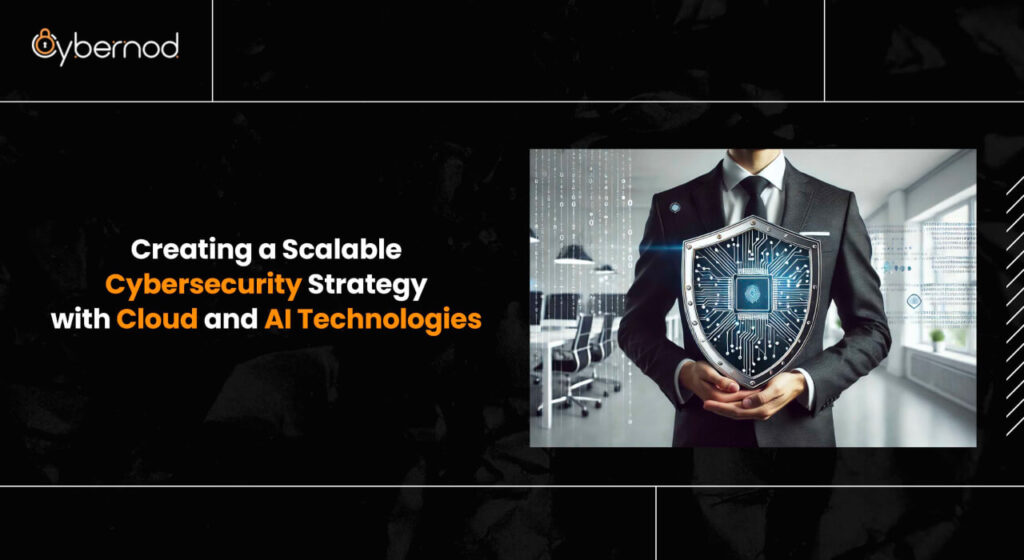
Protecting Against the Evolving Cyber Threats in the UAE
Cybersecurity, the practice of safeguarding digital assets from unauthorized access, use, disclosure, disruption, modification, or destruction, has emerged as a paramount concern in contemporary business operations. As the UAE rapidly transforms into a digital economy, organizations within the region are increasingly exposed to a complex and evolving threat landscape. The convergence of factors such as the rapid proliferation of connected devices, the increasing sophistication of cyberattacks, and the substantial value of digital assets has elevated cybersecurity to a strategic imperative.
A scalable cybersecurity strategy is essential for businesses to effectively mitigate risks and protect their operations. By design, such a strategy can adapt to the evolving threat landscape and accommodate business growth while maintaining a robust security posture. The integration of cloud and artificial intelligence technologies offers unprecedented opportunities to enhance cybersecurity defenses. Cloud computing provides scalable infrastructure and robust security controls, while AI empowers organizations to detect threats, respond rapidly, and automate routine security tasks.
Understanding the Cybersecurity Landscape

Cybersecurity encompasses a multifaceted approach to safeguarding digital assets from various threats. A cyber threat represents any potential danger to an information system, while a vulnerability is a weakness that can be exploited to compromise system integrity. A cybersecurity risk is the likelihood of a threat exploiting a vulnerability to cause harm.
The cybersecurity landscape is continually evolving, characterized by the emergence of increasingly sophisticated threats. Ransomware, phishing attacks, and data breaches pose significant challenges to organizations of all sizes. The rapid adoption of digital technologies and cloud computing has further amplified the attack surface, creating new opportunities for cybercriminals.
To effectively navigate this complex environment, organizations must adopt a structured approach to cybersecurity. A cybersecurity framework, such as the National Institute of Standards and Technology (NIST) Cybersecurity Framework, provides a standardized methodology for managing and reducing cybersecurity risk. By implementing a comprehensive framework, businesses can identify and prioritize critical assets, assess vulnerabilities, and develop strategies to protect their systems and data.
Assessing Cybersecurity Maturity

A comprehensive assessment of an organization’s cybersecurity posture is crucial for identifying vulnerabilities and implementing effective countermeasures. By evaluating the current state of security controls, businesses can prioritize investments and resource allocation to enhance their overall resilience.
Key areas for assessment encompass asset identification, which involves cataloging valuable digital assets, threat assessment to understand potential risks, vulnerability management to detect and address weaknesses, incident response capabilities to handle security breaches, and business continuity planning to ensure operational continuity in the face of disruptions.
A cybersecurity risk assessment is a systematic process to identify, analyze, and evaluate potential threats and vulnerabilities to organizational systems, assets, and data. It provides a quantitative and qualitative understanding of risks, enabling organizations to prioritize mitigation strategies. Numerous tools and methodologies, such as vulnerability scanning, penetration testing, and risk matrix analysis, can be employed to conduct thorough assessments.
The Role of Cloud in Cybersecurity

Cloud computing has emerged as a transformative force, offering numerous advantages for organizations, including enhanced cybersecurity capabilities. Its inherent scalability and elasticity enable businesses to adapt to fluctuating workloads and resource demands, reducing the risk of system overloads and potential breaches. Moreover, the shared responsibility model, where cloud providers manage the underlying infrastructure while organizations retain control over their data and applications, can lead to increased security if implemented effectively.
Cloud deployment models vary in terms of the level of control and responsibility shared between the cloud provider and the customer. Infrastructure as a Service (IaaS) provides virtualized computing resources, offering maximum flexibility but requiring extensive security management. Platform as a Service (PaaS) delivers a development environment, reducing the management burden but demanding careful application and data protection. Software as a Service (SaaS) provides fully managed applications, simplifying security but limiting customization options.
Cloud-based security services offer robust protection for organizations. Identity and access management (IAM) solutions ensure authorized access to resources, while data encryption safeguards sensitive information. Intrusion detection and prevention systems (IDPS) monitor network traffic for malicious activity, providing an early warning system. However, cloud security is not without its challenges. Misconfigurations, data breaches, and insider threats pose significant risks. To mitigate these threats, organizations must adopt best practices such as regular security audits, employee training, and incident response planning.
Leveraging AI for Enhanced Cybersecurity

Artificial intelligence (AI) is poised to revolutionize the cybersecurity landscape by augmenting human capabilities and automating complex tasks. By analyzing vast volumes of data, AI-powered systems can identify patterns and anomalies indicative of malicious activity with unprecedented accuracy and speed. This enables organizations to detect threats early, reducing the potential impact of a breach.
AI excels in incident response by automating routine tasks, accelerating investigations, and recommending optimal remediation steps. Security operations centers (SOCs) can leverage AI to prioritize alerts, correlate incidents, and streamline workflows. Additionally, AI-driven security analytics provide valuable insights into threat trends, enabling organizations to proactively strengthen their defenses.
While AI offers immense potential, ethical considerations and challenges must be addressed. Issues such as algorithmic bias, privacy concerns, and the potential for AI-driven attacks require careful attention. Organizations must implement robust governance frameworks and ethical guidelines to ensure the responsible and beneficial use of AI in cybersecurity.
Building a Scalable Cybersecurity Strategy

A robust and scalable cybersecurity strategy necessitates a holistic approach that encompasses multiple dimensions. A risk-based approach is fundamental, enabling organizations to prioritize resources and efforts based on the potential impact of threats. Strong governance and leadership are essential for establishing a clear cybersecurity vision, allocating resources, and ensuring accountability.
Effective cybersecurity requires the integration of people, processes, and technology. Employees must be equipped with the knowledge and skills to recognize and respond to threats. Well-defined security policies and procedures are crucial for operational efficiency. Technology solutions, such as firewalls, intrusion detection systems, and encryption, provide essential protection layers.
Persistent monitoring and enhancement are essential for upholding a robust security posture. Regular assessments, vulnerability scanning, and incident response exercises help identify weaknesses and inform necessary adjustments. Collaboration between IT and business teams is paramount for ensuring that security measures align with organizational objectives.
To implement a scalable cybersecurity strategy, consider the following practical tips:
- Perform a comprehensive risk assessment to identify essential assets and potential vulnerabilities.
- Develop a comprehensive cybersecurity policy framework.
- Invest in employee training and awareness programs.
- Implement robust access controls and identity management practices.
- Utilize automation and artificial intelligence to improve efficiency.
- Regularly review and update the cybersecurity strategy to adapt to evolving threats.
By adopting these principles and practices, organizations can build a resilient cybersecurity framework capable of protecting their assets and supporting long-term growth.
Empowering your employees to identify and mitigate cyber threats significantly strengthens your defenses. Learn how to cultivate a cybersecurity mindset within your team – read ‘Developing a Cybersecurity Mindset‘ for actionable strategies and training resources.
Implementing the Cybersecurity Strategy

Successful implementation of a cybersecurity strategy requires a systematic and disciplined approach. This involves translating the strategy into actionable plans, allocating resources, and establishing clear responsibilities. Employee training and awareness are paramount, as human error remains a significant vulnerability. Regular cybersecurity awareness campaigns should be conducted to reinforce best practices and educate employees about emerging threats.
A comprehensive cybersecurity incident response plan is essential for managing and mitigating the impact of security breaches. The plan should outline steps to be taken in case of an incident, including incident detection, containment, eradication, recovery, and lessons learned.
To ensure the effectiveness of the cybersecurity strategy, regular audits and assessments should be conducted. These evaluations help identify vulnerabilities, measure compliance, and assess the overall security posture. By continuously monitoring and refining the strategy, organizations can adapt to the evolving threat landscape and maintain a strong security posture.
Measuring and Improving Cybersecurity
Key Performance Indicators (KPIs) are essential for evaluating the effectiveness of a cybersecurity strategy. By quantifying security performance, organizations can identify areas for improvement and demonstrate the value of their security investments. Metrics such as mean time to detect (MTD), mean time to respond (MTR), and mean time to recover (MTTR) provide insights into incident response capabilities. Regularly assessing these metrics enables organizations to benchmark their performance against industry standards and continuously enhance their cybersecurity posture.
In conclusion, a robust and scalable cybersecurity strategy is imperative for businesses operating in the UAE’s dynamic digital landscape. By understanding the threat landscape, assessing cybersecurity maturity, leveraging cloud and AI technologies, and implementing effective measures, organizations can significantly enhance their resilience against cyberattacks. Proactive steps to protect sensitive information are essential for business continuity and success.
Categorized in:
Comments